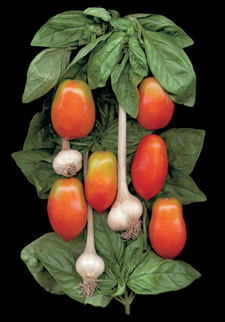
Symphytum x uplandicum ‘Variegatum’, Helianthus ‘Lemon Queen’, Caryopteris x clandonensis, and Hydrangea paniculata ‘Limelight’ inspire a future scheme.
From Grant Meyer’s Southwest garden in winter: A Euphorbia rigida; B Aloe ‘Blue Elf’; C Lachenalia aloides; D Opuntia engelmanii; E Bryophyllum daigremontianum; F Cassia didymabotrya; G Agave americana ‘Variegata’; H Citrofortunella mitis ‘Variegata’.
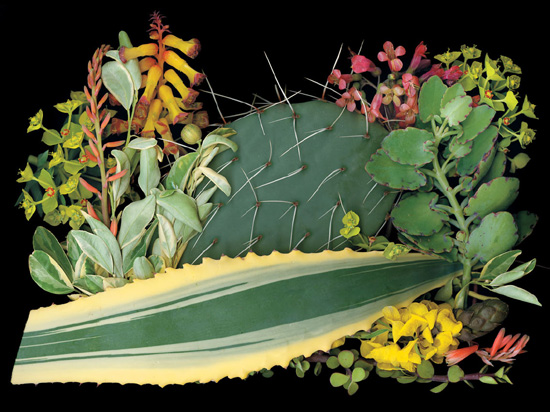

The Edwardian garden designer Gertrude Jekyll is often credited with having invented the perennial border, but her artistic contributions go well beyond that significant accomplishment. She recognized the ephemeral nature of flowers, the persistent role of foliage, and that the most successful compositions combine texture, scale, and color from bulbs, annuals, perennials, shrubs, and trees. To create some of her plantings, Jekyll would wander through landscapes plucking blossoms and leafy branches to bring together, compare, and combine. I also gather flowers and foliage from my garden when I want to visualize a future planting, or if I need to find something to tweak an existing arrangement, I’ll carry a flower from one place to the next, seeking new combinations.
The components of Jekyll’s gatherings and mine have things in common; we both selected cuttings that either work together or present contrasts in form. The plants would need to have similar requirements of light and moisture, and peak at the same moment in the garden. Later, Jekyll might have placed her cuttings in vases to decorate her home or to portray in a watercolor still life. For several months, I brought my samples to Ellen Hoverkamp to construct her stunning arrangements. Our goal was to share suggestions for perfect plant pairings through her images of diverse species harvested and shown in their prime.
For example, at the end of summer when the garden really needed a boost, I picked a cobalt blue flowering spike from the gold-leafed bluebeard shrub (Caryopteris x clandonensis ‘Worcester Gold’). I like to put lemon yellow with blues as a bright accent to make the subdued shades appear more vibrant. So, I cut a few branched flowering stems from a sunflower (Helianthus ‘Lemon Queen’). The colors looked good. Also, the vertical spike of the medium-size bluebeard contrasted with the round, daisy-like sunflowers from that towering herbaceous perennial. Both plants have slender leaves, so I thought I should introduce something to add contrasting volume. I brought in a fluffy hydrangea known for its green-tinged flowers (H. paniculata ‘Limelight’). I needed a lower-growing plant with a different scale for the bottom of my conceptual arrangement, so I picked a leaf of a Russian comfrey known for its variegated foliage—in willow green and butter-cream—Symphytum x uplandicum ‘Axminster Gold’. Next spring, I’ll move these plants together.
When I buy a blooming plant from the nursery in a container, I carry it or just a stem of it around the garden. For the most part, however, I move plants that are already growing in the soil of the garden. New gardeners may not realize that plants are transportable. It takes a bit of confidence to dig up and transplant a prized perennial. But as gardening experience grows, one discovers that most plants—including small trees—can be moved.
We also learn that many plants have to be moved. As most herbaceous perennials age, their stems and roots become congested, and they stop blooming. These plants require renewal and rejuvenation: uprooting, splitting, and replanting. Not only do the plants become more vigorous after being divided, there will be more of each, thus enlarging the troupe and offering opportunities for developing the drifts and sweeps of color and texture that were the hallmarks of Jekyll’s compositions.
You can record these bits and pieces for potential plantings in your garden journal, a useful tool for noting which plants to move in the spring. Natural Companions serves a similar purpose, but we bring the samples to you, and we present an extremely varied palette of plants to acquire. If you are composing a new planting, that’s all the better. Find some of the plants you see in the photographs in this book to combine at the outset. Make lists to take to your garden center—like swatches to the fabric store—and develop confident arrangements with plants that hit their high points simultaneously.
The joy of getting a wonderful plant cutting from a fellow gardening friend has been an inspiration for this book, as well. To put forward a wide-ranging survey, we have gathered plants from colder and warmer climates than where I garden in New Jersey, USDA Zone 6, where temperatures dip to around 10 degrees below zero F. We asked gardeners to send us lists of their favorite combinations, and in many cases, we went to sample their gardens. (Ellen jokingly called these visits “raids.”) A few gardeners from other parts of the country actually picked for us and sent their clippings when weather permitted. Louise Wrinkle provided us with a FedEx box filled with plants from her late winter garden in Birmingham, Alabama. Grant Meyer sent us samples from his Flagstaff, Arizona, garden. Ellen’s plant patron Sandi Blaze invited her to raid her Connecticut gardens, as she has for years. When Ellen and I look at the final images of our friends’ plants, memories of these people and the days we spent in their gardens pop into our minds.
When I visit a public or private garden for inspiration, I usually jot down the plant names (if I can find them), or take a snapshot of a section of a planting including the ground covers in front, the plants of the middle ground, and the taller ones at the back. In most cases, the plants are arranged in the scans to approximate their positions in the garden, from ground up—bottom to top. The low, creeping ground covers are usually placed to form the base of the composition, pieces of tall plants or trees can be seen at the top, and medium-size plants in the middle. The plants in each scan also bloom at the same time and, therefore, may be planted together for a companion effect.
I do not pick from the gardens I visit, of course, unless I have been given permission. And if a gardener is open to the idea of trading plant cuttings to propagate, I am certainly up for that—at the right time of year. Plants in flower rarely make good candidates for propagation. The hardest time for us to reproduce a plant asexually or vegetatively from a cutting is when it is blooming and has put its energy into making fruits and seeds, rather than into producing new, young growth like shoots and roots. Then again, with a good deal of care and a bit of luck, there is a chance that a cutting might just take root.
Propagation is one of my passions. Years ago, I was giving a lecture at Mohonk Mountain House, a nineteenth-century resort near New Paltz, New York. A lovely bouquet had been placed in my room starring a hydrangea with a huge panicle of pure white flowers. I plucked one blossoming stem from the arrangement, cut off the flower, wrapped the cut end in moist tissue, and slipped it into a plastic bag. Today, an eight-foot-tall shrub grown from this source blooms in my garden. Whenever I look at this shrub, I remember that beautiful bouquet and one wonderful weekend of an upstate New York summer.
In general, soft immature tissue roots fastest. That might be the stem of a woody deciduous shrub in spring when it is still new and has not hardened to take on the character of its mature state—green versus brown. Some plants, such as tropical ones, may retain their soft tissue throughout their entire life: Picture a begonia houseplant, for example, or a coleus. Outdoor, hardy herbaceous perennials, those that die back to the ground in winter and return with new growth in the spring, have their times in the season when they are easiest and often fastest to propagate, as well. In this case, too, the cuttings to root are taken from new soft tissue in mid-spring.
We only show pieces of plants in the images. Besides aesthetic concerns, we considered similar needs for sunlight, moisture, and soil conditions.
Another task is to decide how much of each plant is needed for the look you hope to achieve. Some will be planted singly, for instance a specimen tree. An arrangement of two is customary when formality is desired, perhaps two boxwood shrubs flanking the gateway to a garden. Planting in odd numbers—three, five, or more—always looks natural and well integrated.
To establish rhythm, you’ll need repetition. Repeat the same variety of plant, or ones in similar colors and scale, throughout the planting. Heighten drama with contrast by juxtaposing textures, scale, and form.
To create a lush display, you will need plenty of plants. When I hit the nursery or garden center, I tend to go crazy and want to buy one of everything. It is much more effective, however, to buy several of one kind of plant than a lot of different varieties, which results in a polka-dot planting that will not hold together. The most eye-catching and pleasing presentations come from using enough individuals of the same plant—think of those sweeps and drifts of color. Use masses of one type of plant or another for the middle area, and for foreground ground covers. Consult mail-order catalogs and plant reference books to discover the ultimate height and width of a given plant, and estimate the number of each you will need—information that is not always easy to find.
You may not have to buy all the plants you need, since you can propagate your own, from seeds, for instance, or buy one or two of the desired variety, and make more by dividing those and taking cuttings.
Bring along your plant wish list when you go shopping, and also note one or two substitutes—either similar varieties or genera. Perhaps catmint (Nepeta ‘Walker’s Low’) will work if lavender isn’t available.
In order to make the best impression, you will want to have your plantings show up and show off by planning for a background foil. You may be lucky enough to have a low stone wall or be able to build one. Even a simple split-rail fence can work, and certainly a dark evergreen hedge is always becoming.
When planning a bed or border, decide which plants you want to form the structural skeleton of the planting. Generally this framework will be created by shrubs, but they might be subshrubs in a small garden or trees in a large one. These more permanent woody plants set the stage for the various shapes of herbaceous foliage and colors of flowers for the middle and foreground. Remember to leave extra space for young shrubs to grow. The area may look empty in the beginning, but patience will pay off when you find you do not have to dig up and transplant shrubs that are outgrowing their allotted place. If you cannot bear the sight of naked soil or mulch, consider planting annuals or even perennials for a season or two.
Repetition of color, texture, and scale create a rhythm through a planting in Kingston, Washington, by the founders of Heronswood Nursery, Dan Hinkley and Robert Jones.
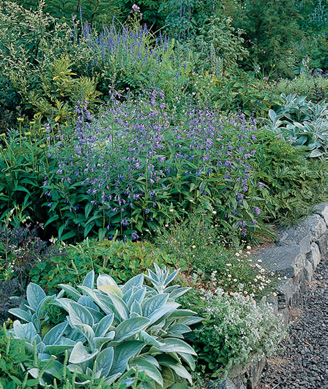
Dates on the calendar are not major markers for gardens. The calendar says the New Year begins on January 1. To a student in North America, the year seems to begin in early September with the advent of school. Imagine the first day of our summer, and then picture a sweltering Christmas Day in Australia when some poor guy has to don a beard and a Santa suit.
The gardener’s year begins when the growing season commences. Perhaps that time we call spring begins when bulbs first appear or when we sow vegetable seeds indoors under lights or in a sunny window. In USDA Zones 2–8, we don’t start seeds on a certain date, like March 15, but instead, six to eight weeks before the last frost is likely to hit in our gardens. After all danger of a killing frost has passed, we can begin to harden off our seedlings for planting outdoors. We take them outdoors for an hour the first day, two the next, and so on; move them to a cold frame; or place them in a sheltered, bright, and wind-free spot for a while.
Spring in the frost-free areas of the California or Florida coast could be said to begin with the end of the rainy season. All plants have a dormant period in their growing cycle, which is usually followed by a burst of new growth and often flowers. We think of dormancy in the northern states as beginning in the fall with shortening hours of daylight and impending cold weather, but dormancy is often a function of available moisture. In dry climates, plants like tulips lose their leaves and retreat to their underground moisture and nutrient storage facilities—bulbs—in summer. When cold weather comes to New England, deciduous trees lose their leaves. Like the dormant tulips, these trees will lack moisture—not because of heat and drought, but since the moisture is locked up in the form of ice and snow.
In this book, we show combinations of plants captured at a particular moment in the garden. However, everyone has to figure out when his or her own season occurs. In a climate where flowering bulbs flourish, the first open blossom on a vernal crocus (Crocus chrysanthus varieties) could mark the arrival of spring. That moment in Alabama may be in January. In Connecticut, it may be in April. The commencement of a new season is relative depending on where you happen to live.
The incredible dream of having every part of a garden appear at the pinnacle of perfection all through the growing season is just that: a fantasy. Even with a staff of professional gardeners, it would be next to impossible to achieve such success. In most of North America, flowering plants look good for days, not weeks or months as they might in places with moderate climates and cool growing seasons like Great Britain, New Zealand, or our own Pacific Northwest coast. Even in the most garden-friendly locations, however, there might be surprises: drought, flood, heat, cold. After years of synchronous blooming, some plants might suddenly stagger their flowering cycles and throw off the timing. Just as often, accidental associations could turn out to be quite wonderful.
When I give friends tours of my garden, I bring them to the places where the action is, and we turn our backs on those spots that are resting. There are usually several places to visit that are reaching their crescendos. Meander: Why race along the arc of the rainbow to reach the pot of gold at the end? Take time to enjoy the journey, and stop along the way.
Time is the common element in every garden, and in every image in this book. But as you’ll see, we’ve arranged our plants to tell many other stories.
John Bierne’s Cercis canadensis varieties: light red ‘Tennessee Pink’; palest ‘Rubye Atkinson’; purple ‘Oklahoma’; light purple species; dark pink ‘Appalachian Red’.
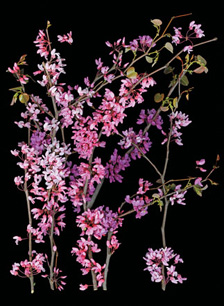
If a plant is doing well for me, I hope to find other species and varieties in the genus to acquire. That is certainly the case with hydrangeas, and especially the cold-hardy and easy-to-grow H. paniculata varieties, of which I have about a dozen.
Which plant is related to another? Recognizing plant families may hint at individual requirements. For instance, most of the hydrangeas and their relatives like acidic soil. It’s fun and fascinating to deduce which family a plant belongs to, but these days, learning a basket full of familial relationships is pretty tough.
It wasn’t always that hard. There were thought to be fewer families even as recently as the turn of the last century. Taxonomists made generalizations based on physical characteristics. Pines are evergreens with long needles; single roses have five petals and so do many of their cousins; mints have square stems, so plants with square stems were considered members of the mint family; and so on. Modern techniques have made more detailed investigations possible. Now scientists use DNA analysis to confirm genetic relationships. The poor lily was once the patriarch of a giant family. Now it is lonely with only a handful of cousins.
The largest of all the families—Asteraceae, the daisies—maintains its standing, despite having had a member genus like Chrysanthemum split into a half dozen or so new genera like Leucanthemum and Tanacetum. These plants still have flowers that typify the daisy family with a central button of tiny fertile flowers surrounded by a ruff of sterile ray florets—the sun-ray petals of black-eyed Susan (Rudbeckia), coneflower (Echinacea), and sunflowers (Helianthus) are among the 1,600 or so other genera. Anomalies abound: Thistles like the artichoke are rayless members of the family.
Plant collectors sometimes fall in love with one genus or another and decide to collect as many species and varieties as possible. Think of the begonia collector, the daylily enthusiast, or the daffodil lover. Assembling such groupings drives the direction of combinations in some collectors’ gardens. At the very least, accumulating more and more relatives simplifies the placement of the latest acquisition. (The new daylily goes in the daylily bed.)
Do these family matters matter to a gardener who is interested primarily in aesthetics? Well, we are all interested in why plants look the way they do and curious about genealogy and relationships. In this book we are looking at combinations and companions—associations. When it comes to associations, perhaps everything is relative.
Late May in central New Jersey: rare bulb Nectoscordum tripedale; Paeonia lactiflora ‘Pink Dawn’; Viburnum plicatum ‘Rosace’ (the large shrub’s pink flowers fade to white through the month).
An array of annual sunflowers from Michael Russo’s summer garden.
Simply put, morphology is the branch of biology that deals with the way plants look. Physiology covers how these physical developments function. In many cases, we gardeners are most interested in plant appearance. Nearly everyone puts fragrance high on his or her list too. Sight-impaired gardeners may find touch most important and like the way plants feel; the glassy surface of one leaf and the velvety texture of another offer an opportunity to contrast characteristics.
The shape of leaves and flowers is important. We appreciate the needle leaves that are the province of most coniferous plants—trees and shrubs that produce cones. The broad leaves of plants like hostas provide a soothing mass of green or, if they have variegation, excitement in a planting. The broad-leafed plants evolved to gather as much light as possible, and this suggests them as candidates for a shady corner of the landscape.
The more variety we bring to a planting, the more interest there will be, especially in the details. In designing a bed or border, however, we might be drawn by the form of a shrub with a bushy, mounding habit of growth. On the other hand, we can capitalize on the spire-like stature of another as punctuation—exclamation points for our compositions. We need to know how tall the trees may grow, and how short the ground covers might be.
Think about the stature and structure of flowers. The flowering stem of a plant or the aggregate of flowers on a blooming stalk is a plant’s inflorescence. Some plants, like alliums, have hemispheric umbels, similar in form to an umbrella, with a multitude of flowers. There are plants like Thalictrum rochebrunianum with many small pale purple, white, and yellow blossoms in their inflorescence that appear like fluttering butterflies atop eight-foot-tall stems. Wisteria flowers are attached to a long stem or raceme, and lilac shrubs bear an accumulation of flowers on a panicle—a branched cluster of blooms. Many plants like camellias, single roses, and the relatives of the asters have simple, wide-open daisy blossoms.
When it comes to living things, flowers in this case, everything is about coevolution. A flat flower provides a bee landing pad for these pollinators and often includes a visual guidance system, for instance, a bull’s-eye in wavelengths of light we cannot see but the bees can. The tubular flower might attract a hummingbird or moth with the corresponding long tongue or unfurled proboscis for sipping nectar and pollinating the blossom in the bargain.
The night-blooming cereus (Epiphyllum oxypetalum), also called queen of the night, blooms only once a year during the hours of darkness and then fades. The flower is huge— at least eight inches across. This Central and South American plant evolved along with its pollinator—a nectar-seeking bat that is attracted by its intense fragrance reminiscent of wintergreen, anise, and honey. Most important for the nocturnal bat, the blossom is bright white to reflect moonlight in the dark jungle understory. Color is usually the most striking aspect of morphology.
Aesthetic relationships encompass shape, stature, and scale, but perhaps color most of all. The way color is perceived is not just subjective, or sociological, but scientifically personal; we all see color a bit differently. Humans perceive color as light striking and reflecting off of objects. Each hue, or pure color, has its own electromagnetic energy visible to the rods and cones in our retinas. The rods are much more numerous, however, it is the cones that interpret shades and tints, hues and tones.
I’ve often said that I know what good taste is. It’s no secret: Good taste is my taste; good taste is your taste. The way we “feel” color is also subjective. Colors may have meanings and associations. Black signifies death to some people; others might think it chic. There are cultural influences, as well. Yellow, for example, may stand for cowardice in our society, but it means courage in Japan, nourishment in China, and mourning in Egypt.
Putting colors together is part of our art. You don’t have to know a lot about color theory to make a pretty planting, but I find that what I’ve learned about color helps me adjust the picture even before I plant. For instance, I know how to make one hue pop or another recede.
The section on color will show many bright examples for inspiration. However, our examination includes green: the color we humans may find has the most visible variation. For the sake of a garden and its plants, green is often considered neutral, a foil for other colors and infrequently used as a major player. But when shades of green lean toward chartreuse, silver, or gold, or leaves are dappled and splashed with yellow or white variegations, they can attract a lot of attention on their own.
Ellen and I have assembled stems, leaves, and flowers to illustrate elements of color theory such as analogous, complementary, and triadic combinations. But putting that all aside, I recommend finding inspiration anywhere you can. Perhaps a room with a window that looks out on the garden could inspire a composition to fill that view. Maybe a flower bed could echo a favorite bedspread or the muted shades of an antique Persian carpet.
It would be fun to interpret a favorite painting with plants using the colors or forms of its elements. It has been said that the paintings of the British master J.M.W. Turner inspired Jekyll. The sky’s the limit for inspiration: Think azure blue and white with sunset pink and orange.
Different Ligularia species demonstrate both mounds of circular leaves and spires of flower-covered spears.
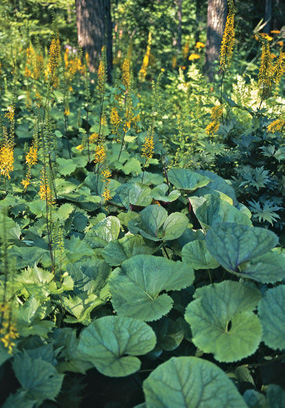
Blossoms of primary colors: blue Eryngium planum ‘Blaukappe’, yellow hybrid Verbascum, and a red Hibiscus syriacus cultivar.
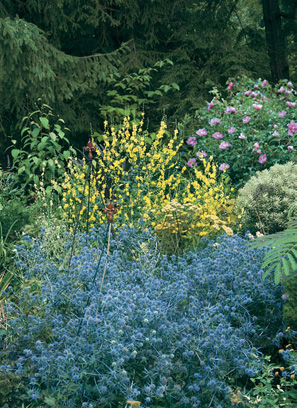
Humans may be able to distinguish the most variation in the color green. (Clockwise from top left) Robinia psuedoacacia ‘Frisia’; Cornus florida ‘Cherokee Sunset’; Alchemilla mollis; Campanula garganica ‘Dickson’s Gold’; Taxus cuspidata ‘Aurescens’; Aralia elata ‘Aureovariegata’; (center) Primula ‘Francesca’.
Many of the plants pictured in this book will thrive in the most populated parts of the United States and places where gardening is especially popular. There are also many regional garden styles that may inspire planting designs. We have created a few images with plants for a California garden. We offer representations of Chinese and Japanese designs, and there is an image that features species like those from the rocky sunbaked countries of the Mediterranean region.
If pressed, I would have to say the noblest resource is nearby nature itself. Consider the small bits of almost wild areas that may be growing near your home. There are very few wild areas left in the United States, but there may be preserves and restorations that can serve as living catalogs of the plants that grew hundreds or thousands of years ago.
I garden on an island in a river. When I first came to this place in 1995, there was a tiny remnant of the plant community that had probably existed here for a thousand years. This “useless” niche had been saved because it wasn’t worth developing. It was on the side of a large rock outcropping right against the river. It didn’t have large trees to cut and couldn’t be cleared for farming or pasture. So it was left alone.
Sadly, this patch of natives is gone now, having been overtaken by weed species that have crept into my county over the last decade and a widely planted invasive ground cover from Europe known well as vinca or periwinkle (Vinca minor), which spread onto the rock from a conventional planted landscape next door.
I put together samples from various plant communities around the country for Ellen to scan featuring indigenous plants. For example, we scanned plants from the tallgrass prairies of the upper Midwest, the forest understory of the Appalachian Mountains, a pond community in the Northeast, and a Mid-Atlantic meadow.
Although I admire the discipline it would take to establish an all-native landscape, I love too many plants to make that stringent a limitation. However, I did create a woodland garden on my property where I grow plants that are or were native to a ten-mile radius of the site—what I call “local species.” I never collect plants from the wild, but grow some nursery-propagated individuals of the same species I first observed there. I gathered flowers from some of those plants for a woodland understory image (here).
I also have a planting in which I have included cultivated varieties (cultivars) of those natives, as well. For example, a ruby selection of the local bleeding heart (Dicentra eximia) that I culled from seedlings myself. I also have a white form of the Virginia bluebells (Mertensia virginica ‘Alba’) and white-flowered redbud (Cercis canadensis ‘Alba’). Oxymoronic names aside, these variations should be kept from escaping into wild areas like alien plants, for sometimes cultivars and hybrids are more vigorous than wild species and could take over local populations.
If you live near the woods, a meadow, or a prairie, you owe it to nature to keep your exotic, fancy ornamental plants close to the house and encourage local plants around the edges of your property. Perhaps the most important thing for a gardener not to do is plant potentially invasive species.
In Natural Companions, we decided not to include known invasive exotic plants—vines like Hall’s honeysuckle (Lonicera japonica ‘Halliana’) and the five-leaf akebia (Akebia quinata). We did not scan chameleon plant (Houttuynia cordata ‘Variegata’) or goutweed (Aegopodium podagraria)—monsters that spread any way they can and, once planted, will most likely outlive the gardener. We didn’t even show the ubiquitous Vinca minor. All of these plants are sold at nurseries and garden centers and through Internet mail-order sources: It is a shame.
Some plants are harmless in one area and downright thugs in another. For example, some Asian ornamental grasses self-sow in warm climates and have invaded meadows and lawns. These same grasses would not be a problem in my garden because my season is too short for their flowers and seeds to ripen. The few Miscanthus species I have do not always bloom, and if they do, it is shortly before the first killing frost, which in some years hits in the middle of September. In any event, I keep an eagle eye on them.
As for a handful of these questionable varieties, I’ve noted them in captions with an asterisk after their names, indicating their invasive potential. These are plants to learn about or keep an eye on and, if they begin to appear where you did not plant them or spread a little too fast, to dispatch (in the trash, not the compost pile) and seek alternatives. If you think I’m being overly dramatic, just imagine if you had to devote a good deal of the precious time you have for our beloved pastime constantly digging out a weed that you yourself brought to the garden.
I do not have plantings inspired by a lot of places due to the limitations of my garden’s mostly shaded valley. I do have a Mediterranean-inspired planting in one of the sunnier spots. I love the plants my friends in Northern California can grow like Phormium, Elegia, Farfugium, Passiflora, Furcraea, Citrus, Aloe, and Abutilon. I have species in these genera that form a summer container garden and, in the fall, retreat to the cool sunroom.
My woodland garden’s citizens include (clockwise from top left) Cornus florida; Uvularia perfoliata; Mertensia virginica ‘Alba’; more off-white dogwood (Cornus); and three-petal Trillium grandiflorum.
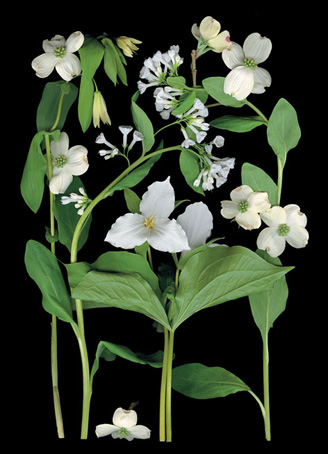
Eustoma, often called Lisianthus, is an annual herbaceous member of the gentian family native from the American Southwest to South America. Hybrids of E. russeliana, which may be pink, violet, white, striped, single or double, are popular to grow as long-lasting cut flowers.
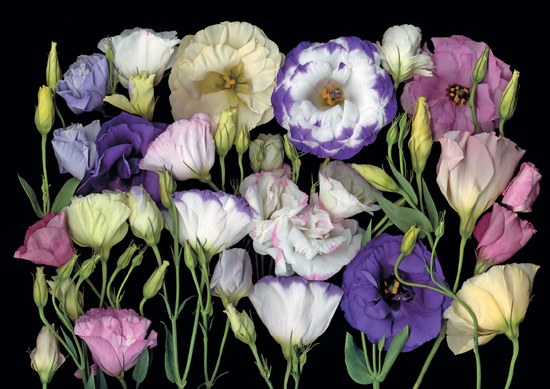
Ellen and I have also gathered plants to tell stories. Perhaps you would like to create a planting for fragrance. Or you might like a butterfly planting that attracts these lovely insects (and their larva). It might be nice to note some of the plants mentioned in the works of William Shakespeare. We have also found inspiration from gardens designed by contemporary landscape architects and by some famous garden artists from the past. We have tried to honor the late English writer and designer Rosemary Verey with an arrangement featuring plants from one of her best-known creations, the Laburnum Walk at Barn-sley House in Gloucestershire in the Cotswolds. One caveat: People who live in the United States do not live in the United Kingdom. That qualification sounds obvious, but I state it here because there are photographs in some books and magazines of perennials and shrubs growing together in gardens that are absolutely irresistible. However, in most parts of the United States, with the possible exception of the Pacific Northwest, flowers do not last as long as they do in the remarkable climate of England. There, lilacs may bloom with roses since the cooler days allow the blossoms to last for weeks and overlap the blooming season of others. On the other hand, in 2010, “lilac time” in my garden seemed like one Tuesday in April. We simply have hotter days. In some cases, this heat has an advantage. Daylilies do very well in America, as do other plants that need the heat of summer to mature.
One of our themes could be said to have been inspired by 1930s English novels. We have a few presentations dealing with medicinal plants, but one garden’s collection of beneficial species may be another’s group of toxic denizens. Very often, these plants are the same—the critical difference being the dosage. A little bit of something could cure, a lot might kill. The foxglove, for example, is the source of the heart medication digitalis, but in higher concentrations, it is the means of dispatching a character in a murder mystery.
To take the storytelling idea a bit further, we have featured a secret garden with subtle plants for a shady oasis. In an even more literal way, we have let the plants tell the story when we feature the Victorian “language of flowers.” There was a time when most plants were assigned a meaning, and people could communicate ideas through them that might not have been proper to say directly. In those days, a young man might pledge his devotion to a young lady by offering her a meaningful bouquet (perhaps along with a language of flowers dictionary). In return, the young lady might have expressed her acceptance, rejection, or indifference with the flowers she gave her suitor in return.
The Victorians also conveyed condolences through flowers. Many people still plan memorial gardens. Using flowers that signify sympathy might be appropriate. Ellen has made an image she calls “Heartsease” (another name for pansies) with comforting plants that have that meaning. We discuss plants for making a sophisticated cutting garden; another image features “farm stand” flowers. We talk about plants appealing to children.
Ellen’s images and the accompanying garden photos are filled with ideas for combinations for various conditions. There are arrangements for shade, partial shade, full sun, and moist or dry locations. There are more combinations for several different climate zones and seasons. You may want to put a few of these companions together for a design in your garden, or you may use this book as a guide for creating floral arrangements with plants gathered from your garden or from your florist shop. Then again, you may just want to scan the pages with your eyes and enjoy the remarkably vivid, deep, and rich pictures.
This book may be just the thing to review when you want to take a break from spring’s hectic gardening schedule and recharge your green fingers. Or on ice-cold evenings in winter, curl up by the fire and dream about future planting combinations with a pile of mail-order nursery catalogs and this book open by your side.
Garden design for kids? How about a circular pizza garden with plum tomatoes, basil, and garlic in wedge-shaped beds?
